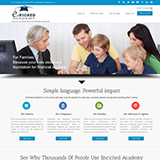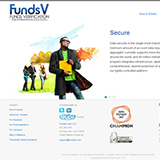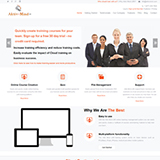Inception
The first phase is the inception phase. Here, the goal is to capture client’s requirements in the documents. We prepare wireframes and Software Requirement Specification (SRS) document for all projects. Wireframes are the structural representation of the website. SRS captures the complete behavior of the system. It includes both functional and non-functional requirements of the system. We recommend detailed use cases for large projects with man effort more than 10 months. Samples of wireframes and SRS are given left.
UI Design Phase
Once the wireframes for the project is ready, the HTML designer sends clients a design questionnaire to capture the UI interface requirements.
Based on the inputs received, our designers prepare 3 mock-ups. Clients may like any one of them or may like to integrate design elements of 2 or more mock-ups into one. In 2-3 more iterations, the design of the home page and internal page is finalized. The designer then works on creating HTML for the website.
Elaboration
The third phase is the elaboration phase. Based on the requirements captured in the first phase, our seasoned architects work on developing the architecture of the application. SRS and wireframes becomes input for this phase. Output is to deliver Technical design documents.
This includes High Level design (HLD) and Low Level Design (LLD). HLD includes designing overall architecture and framework of the project. It is decomposed into modules, functions, classes, entities. LLD includes defining technical interfaces and writing pseudo code. Database design is done. Deliverables include database design diagrams, class architecture diagrams.
Construction
We divide the construction phase into different milestones. The project manager makes a project plan to detail down which functionalities are included in which milestone. Features are prioritized based on business requirements and dependency of the features.
The development team starts working on the first milestone. Once coding and unit testing is done at the developer’s end, he makes an internal release to the QA. The QA tests the functionalities in the testing environment and logs bugs in the issue tracking tool. Once the bugs are fixed and then verified by the QA, we make a release to the client on staging server. The client then reviews the release at his end and logs his feedback / comments in the bug tracking tool.
Transition
At the end of the construction phase, we have an application with all functionalities developed. We then perform a rigorous system testing at our end. Simultaneously, the client also performs user acceptance testing at his/her end. All issues discovered are logged in the bug tracking tool. Once the issues are fixed and the client approves the application, we make a final release on the production server.
Acceptance
At the end of the construction phase, we have an application with all functionalities developed. We then perform a rigorous system testing at our end. Simultaneously, the client also performs user acceptance testing at his/her end. All issues discovered are logged in the bug tracking tool. Once the issues are fixed and the client approves the application, we make a final release on the production server.

















